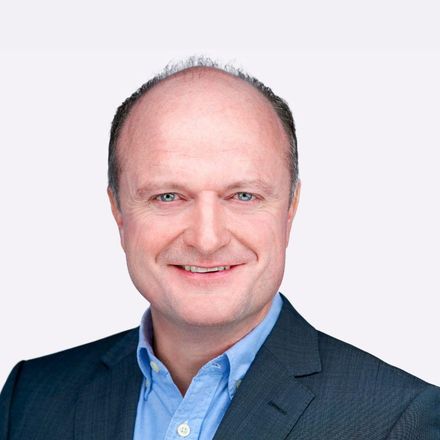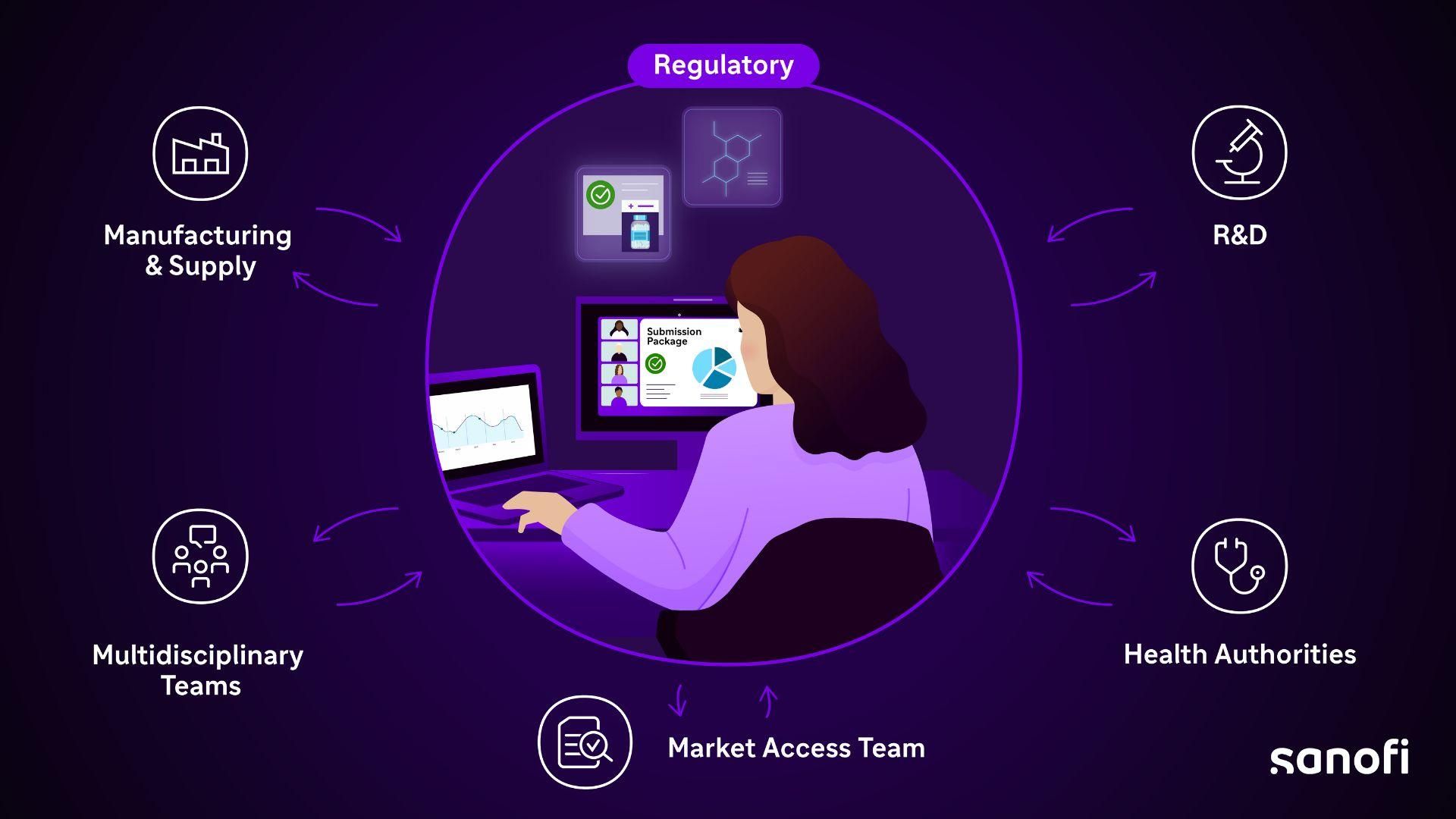Data. Digital. Debate: How Sanofi is Transforming Regulatory Affairs

Regulatory Affairs doesn’t usually steal the spotlight. But it should.
It’s the function at the extraordinary confluence of science and technology, ensuring key discoveries and advancements are delivered to benefit society seamlessly. At Sanofi, we’re on course to transform the practice of medicine through scientific breakthroughs that could have a positive impact on the people and communities we serve. In Regulatory Affairs, we find ourselves in the privileged position to be the cornerstone of this transformation.
Long gone are the days where Regulatory was some sort of enforcement department. Regulatory is nowadays a thought partner and becoming an engine of innovation, a prime mover to make things possible.

Eddie Reilly
Chief Regulatory Officer and Head of Global Regulatory Affairs
For Eddie, this isn’t just theory; it’s the required transformation in progress. From basic research to commercial, from formulation to manufacturing, from internal collaborations to external engagement with health authorities, Regulatory Affairs plays a strategic role across our entire organization. This involves a 1,400-person team of Regulatory professionals who are at the heart of redesigning how medicines enter the world. And it starts with a single question:
How can Regulatory enable access to medications people need years sooner?
A New Shining Lighthouse in Drug Development
As science races forward, quickly enveloping new breakthroughs like gene editing, new modalities, and AI-powered diagnostics, the approach to deliver it safely to patients must also evolve. This is where regulatory lives now, no longer in the shadows of innovation, but side by side with it, illuminating the art of the possible.
A decade ago, Regulatory Affairs was methodical, rules-based, and paper-heavy. Submissions were sequential, one country at a time. Documentation passed from team to team like a relay baton. Risk aversion was the culture. Timelines dragged and because of this, Regulatory was often seen as a blocking agent, not, according to Eddie, because of bad intentions, but because it ran on systems and procedures built for a different world with a different mindset. The price was loss of time, access, and opportunity.
Today, it's clear the discipline is transforming and has transformed. Regulatory is now seen as a strategic partner, balancing compliance with innovation and access and challenging the status quo. Regulatory professionals are embedded at the beginning of drug development, not the end, and are connected to the external world, understanding patient and other stakeholders' needs. Eddie imagines going further beyond, bringing the benefits of multi-fluency, new non-traditional skills, decision making value enhancers, and increased awareness of the interconnectedness within the ecosystem to maximize the art of the possible. An example of how Eddie is building this new vision is with collaborative teams fluent in both science and digital systems, with people who can interpret data, anticipate barriers, and co-create regulatory approaches and pathways with health authorities, to help the process forward at all levels.

“We need at least bilingual Regulatory professionals—people who speak both innovation and infrastructure,” he says. “And we need to give them space to think creatively.” So, Regulatory launched “Learning Fridays”, two hours a week, meeting-free, to learn, explore, and grow. It wasn’t a training mandate. It was a mindset shift. Whether it’s watching a TED Talk on critical thinking or diving into AI ethics, the goal is to equip Regulatory professionals with both digital literacy and strategic agility. According to Eddie, Sanofi is investing in both tools and in the people who will know how best and when to use them to gain the insights needed to move forward impactfully.
Sanofi began investing in its Regulatory data infrastructure, moving toward structured, interoperable formats aligned with global standards like Identification of Medicinal Products (IDMP), Structured Product Labeling (SPL) or Fast Healthcare Interoperability Resources (FHIR). They introduced tools powered by natural language processing, automated translations, and AI-generated drafts. And critically, they started embedding Regulatory from day one as thought partners—for example at R&D design tables, not just submission sprints.
“This isn’t about reacting to science,” Eddie says. “It’s about being part of it.”
Into the Big Bet: Real-Time, Real Impact
One of the biggest inflection points came with Accumulus Synergy—a cloud-based platform co-developed by industry and regulators with the aim to enable real-time data exchange. Sanofi is helping to build it and adopt it, and Eddie joined the board.
The premise was simple but radical: submissions could be shared with multiple global agencies immediately. Reviews could happen in parallel with the scientific process, not after it. Bottlenecks could become breakthroughs. Accumulus is now operating across more than 50 countries and continues to build its capabilities and impact.
Eddie points to another example of acceleration driven by an innovative mindset coupled with technological advances. Sanofi wanted to expand a therapy to younger patients, but traditional trials weren’t feasible due to several constraints. So, the Development team turned to quantitative systems pharmacology modeling. They created a virtual simulation robust enough to stand as regulatory-grade evidence, modeling how the drug would behave in a younger population based on adult data. The FDA reviewed the data. And approved the extension.
“That was a moment,” Eddie says. “It showed that with the right approach, the right argument and the right data, the regulators will partner in adopting new standards in evidence.”
Transformation Beyond the Tools
Today, Sanofi’s Regulatory teams are working differently. They’re embedded with clinical, R&D and other key interfaces across Sanofi from day one. Strategies are built from internal and external engagement and co-authored with global authorities. They’re using automation and novel technologies to accelerate across the portfolio of activities, including variation approvals—sometimes completing in days, not months.
They’re also rethinking how talent grows. Eddie calls it building "bionic" teams—humans empowered by machines, not replaced by them.
“AI is a tool,” he says, “that humans can use strategically to increase efficiency and gain quick insights.”
In practice, AI is helping streamline the work that once slowed Regulatory teams down—drafting documents, translating content, and flagging inconsistencies. These technologies are powerful accelerators, but they’re not decision-makers. They create the space for Regulatory professionals to do what only humans can: apply strategy, make scientific judgments, and build trust with health authorities and the society we serve. And the future is already unfolding, with automated response generation, dynamic dossiers, and connected health systems that inform post-market surveillance and next-gen development.
Partnership with Health Authorities extends beyond traditional interactions, as Sanofi pioneers innovative engagement approaches with regulators worldwide, including collaborative educational sessions across key markets, fostering deeper partnerships that transcend conventional regulatory relationships. These forward-thinking dialogues underline our commitment to evolving from standard submissions to strategic collaboration.
“We’re just getting started,” Eddie says. “The more we standardize, the more we can automate. And the more we automate, the more we can focus our talent on the science and benefits to society that truly matters.”
The New Rhythm of Innovation
Regulatory isn’t the end of the story anymore. It’s the tempo that drives it forward.
“Regulatory is where science meets society’s needs,” Eddie says. “It’s where the patient’s access to new therapies becomes real.” At Sanofi, our Fit-for-Future transformation is talent driven and moving faster, smarter, and becoming more human—with data, digital tools, and dialogue at its core.
This is regulatory reinvented, and Sanofi is setting the pace.